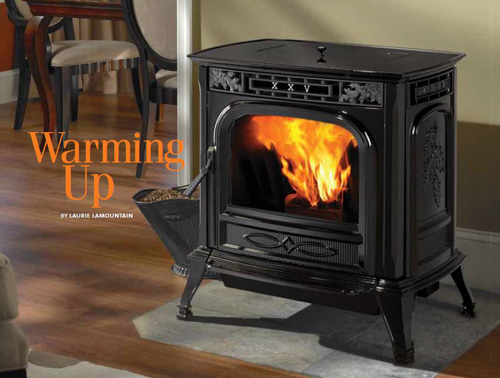 |
|
Warming Upby Laurie LaMountain There are times when the lack of something we perceive as In order to meet the growing consumer demand for these “modern” When it comes to home heating, wood stoves may not strike you as high-tech, especially when you consider their rather lowtech revival, but over the last forty years the industry as a whole has evolved to meet growing demands for cleaner burning, more efficient stoves. Richard points out that a wood stove manufactured to today’s standards burns almost 100% cleaner than a wood stove built in the ‘70s. “We need to replace these older wood stoves with more efficient,
cleaner burning stoves. A lot of people may have a useful wood
stove, but they don’t realize what damage it’s doing to the environment,” says Richard. He tells the story of The Wood Stove Changeout
in Libby, Montana. Libby is located in the remote northwest While wood stove manufacturers were busy cleaning up their
act, pellet stove manufacturers were just getting warmed up. The
1973 oil crisis also led to the invention of the first pellet stove in
Washington State that same year, but it wasn’t until the early ‘80s
that manufacturing began in earnest. When the Pellet Fuels Institute Richard estimates that 60% of business at Frost & Flame is currently conducted in pellet stoves. He cites New England as accounting for the lion’s share of the pellet industry, and Maine as one of the strongest states. The turning point in Maine, he notes, was around the time of the economic downturn in 2008 when fuel prices conversely spiked. The media stepped up and very quickly began to educate people about the merits of pellet burning stoves, and the market in Maine has been growing ever since. I’m one of those diehard wood stove owners who extolls the
virtues of heating with wood. It’s there during a power outage, it’s
aromatic, it’s quiet, etc., but I have to admit, when given the merits
of a pellet burning stove versus wood, I’m impressed. In response to
my claim that my wood stove is insurance against a power outage, A pellet stove can be directly vented to the outside or through a
vertical chimney that is typically three to four inches in diameter. It
requires less clearance than a wood stove because it distributes heat
from the front, thereby saving space. It can be operated manually
or with a thermostat. By being able to regulate it, it’s easier and Like anything higher tech, pellet stoves require more consumer education. Richard points out that they feature a highly mechanized electrical system with pretty sophisticated circuitry. Because of this, he recommends cleaning your pellet stove weekly during use, a fifteen minute event that involves emptying the burn pot and ash pan, and having it serviced annually, just as you would a furnace. He also shares a valuable lesson in pellet composition. There
are typically three grades of pellets, with the premium grade being
composed entirely of softwood, the mid-grade a combination of
soft and hardwood and the least expensive being hardwood. The
uneducated consumer might assume that hardwood, as it is with Richard is quick to add that, since their inception in the late ‘80s, gas stoves have come a long way. Numerous technological advances have made them more efficient and less expensive than in the past. Initially, they were little more than a wood stove with a gas burner and a couple of fake logs inside. They were more decorative than a true heater, but within three or four years manufacturers improved the product so much that most of them became heater-rated gas stoves. In most situations, you can’t tell the difference between the fire in a gas stove and that in a woodburning stove. Gas continues to account for a large segment of the market
due to its convenience and ease of use; just push a button on the
remote control or the unit. Another advantage to a gas stove is it
doesn’t require electricity to run, so in the event of a power outage,
homeowners are assured of a heat source to keep them warm and There’s an invaluable advantage to buying a stove from someone who has twenty-eight years of experience selling, installing and servicing them. All things considered, Richard will take the time to determine which product best serves your home heating needs. *Source: http://www.woodstovechangeout.org/index.php?id=27
|
